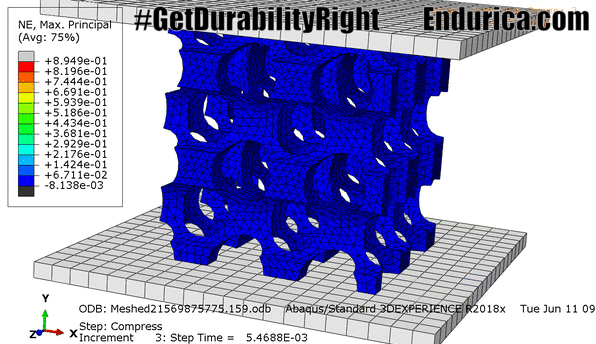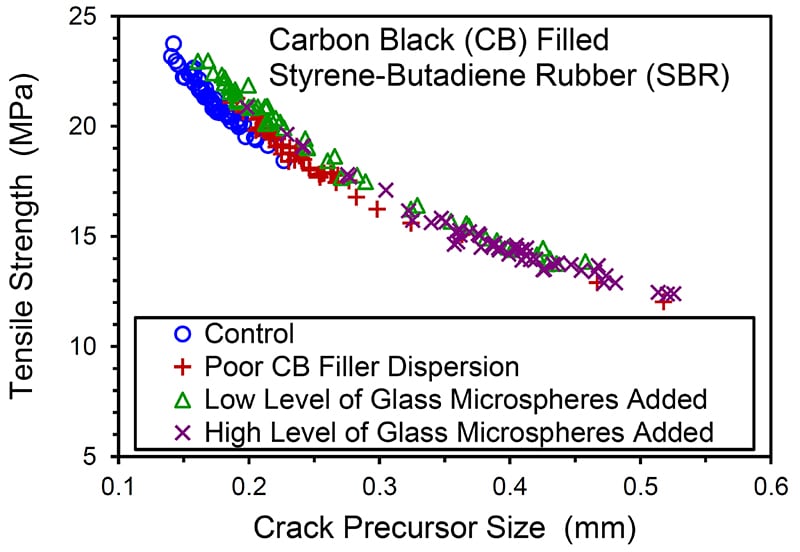If you are involved in 3D printing with elastomers, can you predict the fatigue behavior?
How is product lifetime affected by complex lattice designs with multiaxial stresses, and what is the impact of printing defects?
Scientific literature and social media are abound with amazing examples of the potential for 3D printed articles made from metals, plastics and elastomers for use in many fields including the biomedical area. Researchers at ETH Zürich recently 3D printed a functioning artificial heart made from a silicone material. A picture of the device is shown below, and the story can be viewed elsewhere.1,2 This pioneering work represents a very noteworthy achievement. This research also highlights the importance of understanding elastomer durability in these cutting edge applications, as the silicone heart only survived 3,000 beats or about 30 minutes.

One of the key differences between 3D printing (additive manufacturing) and conventional manufacturing is the ability of 3D printing processes to create complex structures containing open spaces, often lattice-like in nature. Perhaps the most innovative and high profile example of a 3D printed product with lattice construction is the midsole for the Adidas Futurecraft 4D shoe that is created using the Carbon 3D technology.3

Overall stresses that are relatively modest and unidirectional translate into much higher stress, multiaxial conditions within the struts of a lattice structure like the shoe sole example above. The finite element simulation below illustrates this for a lattice structure undergoing simple compression (thanks to Mark Bauman, engineering analyst at Endurica).

Multiaxial load cases, crack closure considerations, and other complexities that arise in lattice designs and make it impossible to predict fatigue behavior using simplistic approaches such as Wohler / stress(S)-lifetime(N) curves, can be readily handled using the Endurica CL elastomer fatigue solver for Abaqus, MSC Marc, and ANSYS finite element analysis to predict when and where cracks will show up in the structure.
Cracks in an elastomer start out as microscopic precursors that grow due to applied cyclic loading according to a characteristic crack growth rate law for the material.4 In combination with critical plane analysis, this rubber fracture mechanics approach is the cornerstone of our Endurica CL software. The crack precursors – also called intrinsic defects or flaws – are especially important to pay attention to in the additive manufacturing of products in which voids or defects can be introduced by the printing process. The Core Module of our Fatigue Property Mapping testing services includes quantification of crack precursor size, and our new Reliability Module characterizes its distribution. The figure below illustrates the clear influence of crack precursor size on tensile strength in a study wherein we intentionally introduced glass microspheres as flaws in the rubber compound.5 Fatigue lifetime shows the same strong dependence on flaw size.

Endurica has the software, testing solutions, and expertise to help you understand and improve the durability of your 3D printed elastomer applications, so contact us to see how we can help you #GetDurabilityRight in the additive manufacturing world.
References
- https://www.sciencealert.com/this-3d-printed-soft-artificial-heart-beats-just-like-a-real-one
- https://www.youtube.com/watch?v=YUYNXeHfTdQ
- https://www.youtube.com/watch?v=qlomslovAnI
- W. V. Mars, “Fatigue life prediction for elastomeric structures”, Rubber Chemistry and Technology 80, 481 (2007), https://doi.org/10.5254/1.3548175.
- C. G. Robertson, L. B. Tunnicliffe, L. Maciag, M. A. Bauman, K. Miller, C. R. Herd, and W. V. Mars, “Characterizing Tensile Strength Distribution to Evaluate Filler Dispersion Effects and Reliability of Rubber”, paper presented at the Fall 196th Technical Meeting of the Rubber Division, American Chemical Society (International Elastomer Conference), Cleveland, OH, October 8-10, 2019.
